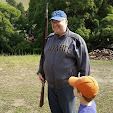Now I move on to the main color. Some people call this highlighting, and sometimes I do too, but it's not really. On rare occasions I will apply an actual highlight of a third color, but these shades do not really need that.
First the uniform coat gets a main shade of fairly bright green.
Then I use a straight red.
I do not use a straight white, but Oyster White, which has a slight cream tone.
I mixed my own main color for the blanket rolls. It is about one part Dark Chocolate (my shade color) to two parts Territorial Beige.
The flesh comes nearly last. This is Delta's Medium Flesh.
The leather work gets a main shade of autumn brown.
Here is the drum in the shade colors.
Below the drum head gets a highlight of Latte.
Finally the drum sticks get a main tone of Toffee Brown.
Here are the finished figures. Compare these with the previous post. These figures should "pop" off the table. By starting with the shade tone and building the main shade above it, I can accentuate the natural relief of the figures.
I started painting this eight man unit today. I probably put in four hours in painting these, and that includes time spent photographing and blogging.

































nice blog
ReplyDeleteYou make it look so simple, and nice to see the use of 'cheaper' craft paints, instead of the rather expensive small pots us hobbyists are used to using. Why do you use the red you do? Is the coverage better?
ReplyDeleteVery interesting insight into your technique. I was thinking of the doing the same myself (particularly for 15mm figures) to the tutorial has been very useful.
ReplyDeleteCheers WW
Thanks - I might give that method a try for my Spanish Napoleonics I am going to be painting shortly.
ReplyDeleteWonderful tutorial, Scott.
ReplyDeleteI've tried using craft paints but they go on very thin and then nearly every bottle I buy ends up with large blobs of semisolids. I don't know how you manage but I love the results!
Great technique...great results.
ReplyDeleteThanks for teh painting guide. It is your whites that have always fascinated me, as I find I struggle with coverage over black, so really helpful to see the actual paints you use in your painting guides. Would love to see you do a French infantry guide :-)
ReplyDeleteThanks for the tutorial. Your figures do really pop, and this shows how you achieve it very well.
ReplyDeleteAppreciate the tutorial -excellent
ReplyDeleteWhen I contacted our supplier (I live in NZ) for the paints - they didn't have some of the ones you had named - are those names still current? eg oyster white
Craig, they are still current in the states. Delta has an annoying habit of withdrawing their colors frequently.
ReplyDelete